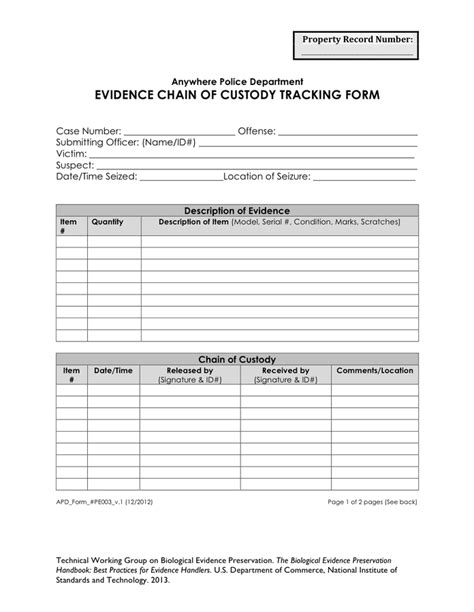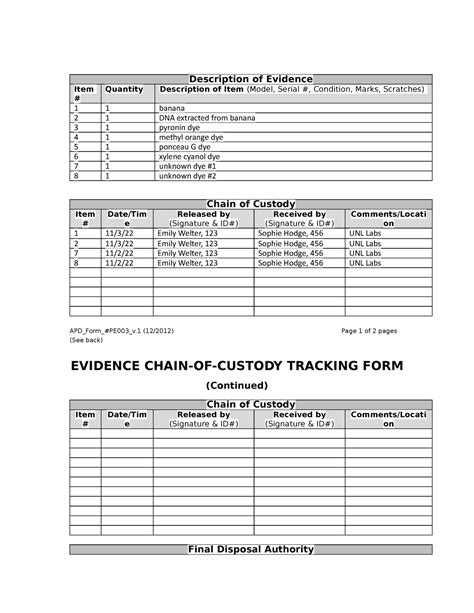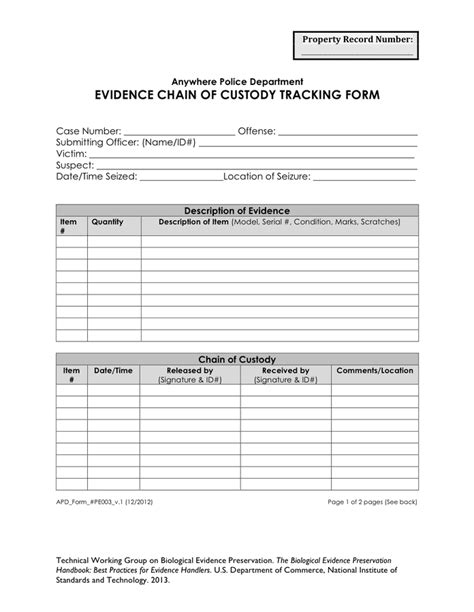Chain Of Custody Document

The Chain of Custody (CoC) document is a crucial element in the field of evidence management, particularly in legal and forensic contexts. It serves as a comprehensive record that traces the path of a piece of evidence from its initial collection to its final disposition, ensuring its integrity and admissibility in legal proceedings. This article delves into the intricacies of the Chain of Custody document, exploring its purpose, key components, and its critical role in maintaining the evidentiary value of physical and digital evidence.
Understanding the Chain of Custody Document

The Chain of Custody document is a meticulously detailed account that chronicles the journey of evidence, be it a physical object, a digital file, or any other form of information relevant to an investigation. Its primary objective is to establish an unbroken link of possession, demonstrating that the evidence has remained secure, unaltered, and in the custody of authorized individuals or entities throughout its lifecycle.
By documenting each step of the evidence's journey, from collection to storage, analysis, and ultimately, its presentation in court, the Chain of Custody document provides a transparent and auditable trail. This transparency is vital to ensure that the evidence has not been compromised, tampered with, or mishandled in any way, thereby maintaining its integrity and reliability.
In the digital age, where evidence often exists in electronic form, the Chain of Custody document takes on added significance. It not only tracks the physical custody of digital evidence but also the digital processes and environments in which the evidence is handled. This includes recording details such as the initial acquisition of digital evidence, its transfer to secure storage, any forensic analysis conducted, and the methods used to ensure the authenticity and integrity of the data.
Key Components of a Chain of Custody Document
A well-structured Chain of Custody document typically includes several critical components, each serving a specific purpose in preserving the integrity of the evidence:
- Evidence Description: A detailed and accurate description of the evidence is essential. This includes physical characteristics, unique identifiers, and any distinguishing features. For digital evidence, this may involve specifying file types, sizes, and hash values.
- Collection Details: The Chain of Custody document should record the date, time, and location of evidence collection. It should also document the collector's identity and any relevant circumstances or observations made during the collection process.
- Custodian Information: A comprehensive list of individuals or entities who have had custody of the evidence is crucial. This includes the names, roles, and contact details of those responsible for collecting, transporting, storing, and analyzing the evidence.
- Storage and Transportation Details: The document should provide an account of how the evidence was stored and transported. This includes the type of storage containers used, the conditions under which the evidence was kept (e.g., temperature, humidity), and the methods employed to ensure its secure transportation.
- Analysis and Testing: If the evidence has undergone any form of analysis or testing, the Chain of Custody document should detail the procedures, the analysts involved, and the results obtained. This ensures that any subsequent interpretations or conclusions are based on reliable data.
- Documentation and Photography: The document should include references to any supporting documentation, such as photographs, videos, or other records that provide additional context or evidence of the chain's integrity. These visual records can be invaluable in substantiating the evidence's authenticity.
- Chain of Custody Forms: These are specialized forms used to record each step of the evidence's journey. They typically include sections for initial collection, storage, transportation, analysis, and final disposition. These forms are signed and dated by each custodian, providing an auditable trail of possession.
Ensuring Integrity and Admissibility

The Chain of Custody document plays a pivotal role in maintaining the integrity and admissibility of evidence in legal proceedings. By providing a clear and detailed account of the evidence’s journey, it helps to establish its authenticity and reliability. This is particularly critical in cases where the evidence may be challenged or where its integrity is crucial to the outcome of the case.
For example, in a criminal investigation, the Chain of Custody document can be used to refute claims of evidence tampering or contamination. It can also provide a clear audit trail, demonstrating that the evidence has been handled according to established protocols and legal requirements. This level of transparency and accountability is essential to uphold the principles of justice and ensure fair trials.
Challenges and Best Practices
While the Chain of Custody document is a powerful tool, it is not without its challenges. One of the primary difficulties is maintaining the document’s accuracy and completeness, especially in complex investigations where multiple agencies or individuals may be involved. It is essential to ensure that all relevant details are recorded and that the document is regularly updated to reflect any changes in the evidence’s status.
To address these challenges, several best practices have emerged. These include implementing rigorous training programs for evidence handlers, utilizing standardized Chain of Custody forms and procedures, and employing digital solutions to streamline the documentation process. Digital tools can automate certain aspects of the Chain of Custody, reducing the risk of errors and providing real-time updates to the document.
Furthermore, it is crucial to establish clear protocols for evidence handling and to ensure that all personnel involved are aware of their responsibilities and the potential consequences of mishandling evidence. Regular audits and reviews of the Chain of Custody process can also help identify areas for improvement and ensure that the system remains robust and effective.
Future Trends and Innovations
As technology continues to advance, the field of evidence management is evolving, and the Chain of Custody document is no exception. Emerging technologies, such as blockchain and digital signatures, are being explored to enhance the security and integrity of the Chain of Custody process.
Blockchain technology, with its distributed ledger system, offers a secure and transparent way to record and verify the Chain of Custody. Each step in the evidence's journey can be recorded as a transaction on the blockchain, creating an immutable and auditable trail. Digital signatures, meanwhile, can provide a secure and verifiable means of authentication, ensuring that the Chain of Custody document remains tamper-proof.
Additionally, the integration of artificial intelligence and machine learning into evidence management systems holds promise. These technologies can automate certain aspects of the Chain of Custody, such as identifying and flagging potential issues or inconsistencies, and can assist in the analysis and interpretation of large datasets.
Conclusion
The Chain of Custody document is a cornerstone of evidence management, providing a critical link between the evidence and its admissibility in legal proceedings. By meticulously documenting the journey of evidence, it ensures its integrity and reliability, upholding the principles of justice and fair trials. As technology advances, the Chain of Custody document will continue to evolve, incorporating innovative solutions to enhance its security, transparency, and effectiveness.
How is the Chain of Custody document used in court proceedings?
+
The Chain of Custody document is a critical tool in court proceedings, as it provides a detailed account of the evidence’s journey from collection to presentation. It helps establish the authenticity and integrity of the evidence, ensuring that it has not been tampered with or compromised. This documentation is often used to support the admissibility of evidence and can be crucial in establishing the reliability of forensic findings.
What are some common challenges in maintaining an accurate Chain of Custody document?
+
Maintaining an accurate Chain of Custody document can be challenging, especially in complex investigations. Some common challenges include multiple agencies or individuals handling the evidence, potential for human error in documentation, and the need to keep the document updated in real-time. These challenges can be mitigated through rigorous training, standardized procedures, and the use of digital tools.
How can technology enhance the Chain of Custody process?
+
Technology can significantly enhance the Chain of Custody process by providing more secure and transparent methods of documentation. Blockchain technology, for instance, can create an immutable record of each step in the evidence’s journey. Digital signatures can provide secure authentication, and AI/ML can assist in analyzing large datasets and identifying potential issues.



